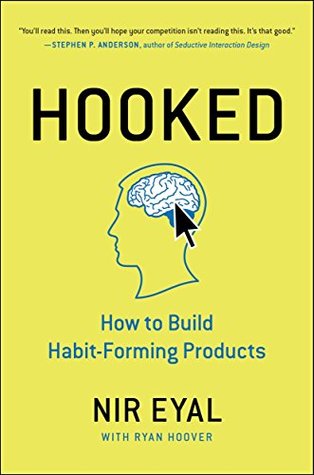More on this book
Community
Kindle Notes & Highlights
by
Nir Eyal
Read between
December 19, 2019 - January 8, 2020
a four- phase process companies use to forms habits.
Through consecutive Hook cycles, successful products reach their ultimate goal of unprompted user engagement, bringing users back repeatedly, without depending on costly advertising or aggressive messaging. While I draw many examples from technology companies given my industry background, hooks are everywhere— in apps, sports, movies, games, and even our jobs. Hooks can be found in virtually any experience that burrows into our minds (and often our wallets). The four steps of the Hook Model provide the framework for the chapters of this book. The Hook Model
Choice architecture, a concept described by famed scholars Thaler, Sunstein, and Balz in their same-titled scholarly paper, offers techniques to influence people’s decisions and affect behavioral outcomes.
The Hook Model has four phases: trigger, action, variable reward, and investment.
Once a habit is formed, the user is automatically triggered to use the product during routine events such as wanting to kill time while waiting in line.
Users who continuously find value in a product are more likely to tell their friends about it.
Viral Cycle Time is the amount of time it takes a user to invite another user, and it can have a massive impact.
Products that change customer routines are less susceptible to attacks from other companies.
“many innovations fail because consumers irrationally overvalue the old while companies irrationally overvalue the new.”
If a user is familiar with the Google interface, switching to Bing requires cognitive effort.
action to become a habit, the user must perceive a high degree of utility, either from gaining pleasure or avoiding pain.
A company can begin to determine its product’s habit-forming potential by plotting two factors: frequency (how often the behavior occurs) and perceived utility (how useful and rewarding the behavior is in the user’s mind over alternative solutions).
infrequent behaviors remain conscious actions and never create the automatic response that is characteristic of habits.
Painkillers solve an obvious need, relieving a specific pain, and often have quantifiable markets.
A habit is when not doing an action causes a bit of pain.
First, the company must identify the particular frustration or pain point in emotional terms, rather than product features.
What would your users want to achieve by using your solution? Where and when will they use it? What emotions influence their use and will trigger them to action?
“[If] you want to build a product that is relevant to folks, you need to put yourself in their shoes and you need to write a story from their side. So, we spend a lot of time writing what’s called user narratives.”
Fogg posits that there are three ingredients required to initiate any and all behaviors: (1) the user must have sufficient motivation; (2) the user must have the ability to complete the desired action; and (3) a trigger must be present to activate the behavior.
The Fogg Behavior Model is represented in the formula B = MAT, which represents that a given behavior will occur when motivation, ability, and a trigger are present at the same time and in sufficient degrees.
defines motivation as “the energy for action.”2
Consequently, any technology or product that significantly reduces the steps to complete a task will enjoy high adoption rates by the people it assists.
People often anchor to one piece of information when making a decision.
The study demonstrates the endowed progress effect, a phenomenon that increases motivation as people believe they are nearing a goal.
The study revealed that what draws us to act is not the sensation we receive from the reward itself, but the need to alleviate the craving for that reward.
Our brains are adapted to seek rewards that make us feel accepted, attractive, important, and included.
With every post, tweet, or pin, users anticipate social validation.
reactance, the hair-trigger response to threats to your autonomy.
Adopting a weird new behavior— calorie tracking, in my case—felt like something I had to do, not something I wanted to do.
However, it leverages familiar behaviors users want to do, instead of have to do.
but the fact remains that the most successful consumer technologies—those that have altered the daily behaviors of hundreds of millions of people—are the ones that nobody makes us use.
Unfortunately, too many companies build their products betting users will do what they make them do instead of letting them do what they want to do.
Online games like FarmVille suffer from what I term finite variability—an experience that becomes predictable after use.
The more users invest time and effort into a product or service, the more they value it. In fact, there is ample evidence to suggest that our labor leads to love.
Little investments, such as placing a tiny sign in a window, can lead to big changes in future behaviors.
“It’s OK to deceive people if it’s in their best interests, or if they’ve given implicit consent to be deceived


